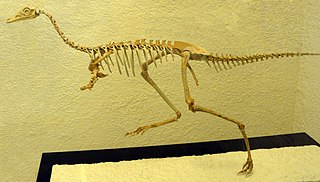Related Research Articles

Genome projects are scientific endeavours that ultimately aim to determine the complete genome sequence of an organism and to annotate protein-coding genes and other important genome-encoded features. The genome sequence of an organism includes the collective DNA sequences of each chromosome in the organism. For a bacterium containing a single chromosome, a genome project will aim to map the sequence of that chromosome. For the human species, whose genome includes 22 pairs of autosomes and 2 sex chromosomes, a complete genome sequence will involve 46 separate chromosome sequences.

Crassostrea is a genus of true oysters containing some of the most important oysters used for food. Some species in the genus have been moved to the genus Magallana.

Alvarezsauridae is a family of small, long-legged dinosaurs. Although originally thought to represent the earliest known flightless birds, a consensus of recent work suggests that they evolved from an early branch of maniraptoran theropods. Alvarezsaurids were highly specialized. They had tiny but stout forelimbs, with compact, bird-like hands. Their skeletons suggest that they had massive breast and arm muscles, possibly adapted for digging or tearing. They had long, tube-shaped snouts filled with tiny teeth. They may have been adapted to prey on colonial insects such as termites.

Suo Chao is a fictional character in Water Margin, one of the Four Great Classical Novels in Chinese literature. Nicknamed "Impatient Vanguard", he ranks 19th among the 36 Heavenly Spirits, the first third of the 108 Stars of Destiny.

Yang Lin is a fictional character in Water Margin, one of the Four Great Classical Novels in Chinese literature. Nicknamed "Sleek Leopard", he ranks 51st among the 108 Stars of Destiny and 15th among the 72 Earthly Fiends.
The Book of Jin is an official Chinese historical text covering the history of the Jin dynasty from 265 to 420. It was compiled in 648 by a number of officials commissioned by the imperial court of the Tang dynasty, with chancellor Fang Xuanling as the lead editor, drawing mostly from official documents left from earlier archives. A few essays in volumes 1, 3, 54 and 80 were composed by the Tang dynasty's Emperor Taizong himself. The contents of the Book of Jin, however, included not only the history of the Jin dynasty, but also that of the Sixteen Kingdoms period, which was contemporaneous with the Eastern Jin dynasty.

Chin Yang Lee was a Chinese American author best known for his 1957 novel The Flower Drum Song, which inspired the Rodgers and Hammerstein musical Flower Drum Song and the eponymous 1961 film which was nominated for five Academy Awards.
Nanorana parkeri is a species of frogs in the family Dicroglossidae. It is found in Tibet (China) and in Nepal, but it is expected to be found also in Bhutan and parts of India. It is the second amphibian, and the first Neobatrachian, to have its whole genome published.

All Men Are Brothers, also known as Seven Soldiers of Kung Fu, is a 1975 Hong Kong wuxia film based on the Chinese classical 14th century novel Water Margin. The film was produced by the Shaw Brothers Studio and directed by Chang Cheh and Wu Ma.

The Water Margin is a 1998 Chinese television series adapted from Shi Nai'an's classical 14th-century novel of the same title. It was produced by CCTV with Zhang Jizhong as producer. It was first broadcast in China in January 1998. The series also featured action choreography by Yuen Woo-ping.
Thellungiella is a genus of plants in the family Brassicaceae closely related to Arabidopsis, but in the subclade Eutremeae. In recent classifications, the genus is no longer recognized, and the formerly included species are now placed in the genus Eutrema or Schrenkiella.

End-sequence profiling (ESP) is a method based on sequence-tagged connectors developed to facilitate de novo genome sequencing to identify high-resolution copy number and structural aberrations such as inversions and translocations.
Deinococcus deserti is a Gram-negative, rod-shaped bacterium that belongs to the Deinococcaceae, a group of extremely radiotolerant bacteria. D. deserti and other Deinococcaceae exhibit an extraordinary ability to withstand ionizing radiation.
Hymenobacter deserti is a Gram-negative, rod-shaped and non-motile bacterium from the genus of Hymenobacter which has been isolated from soil from the desert of Xinjiang in China.
"Paramesorhizobium deserti" is an antibiotic resistant bacterium from the genus "Paramesorhizobium" which has been isolated from soil from the Taklimakan Desert in China.
Saccharopolyspora deserti is a halotolerant bacterium from the genus of Saccharopolyspora which has been isolated from sand from Saudi Arabia.
Bat coronavirus RaTG13 is a SARS-like betacoronavirus that infects the horseshoe bat Rhinolophus affinis. It was discovered in 2013 in bat droppings from a mining cave near the town of Tongguan in Mojiang county in Yunnan, China. As of 2020, it is the closest known relative of SARS-CoV-2, the virus that causes COVID-19.
RmYN02 is a bat-derived strain of Severe acute respiratory syndrome–related coronavirus. It was discovered in bat droppings collected between May and October 2019 from sites in Mengla County, Yunnan Province, China. It is the second-closest known relative of SARS-CoV-2, the virus strain that causes COVID-19, sharing 93.3% nucleotide identity at the scale of the complete virus genome. RmYN02 contains an insertion at the S1/S2 cleavage site in the spike protein, similar to SARS-CoV-2, suggesting that such insertion events can occur naturally, which was the subject of a paper sent to Nature.
RacCS203 is a bat-derived strain of severe acute respiratory syndrome–related coronavirus collected in acuminate horseshoe bats from sites in Thailand. Its has 91.5% similarity to SARS-CoV-2 and is most related to the RmYN02 strain.
References
- 1 2 3 "Paramesorhizobium". www.uniprot.org.
- ↑ Lv, Ruichen; Yang, Xianwei; Fang, Nan; Song, Yuqin; Luo, Xuesong; Guo, Jingyu; Peng, Fang; Yang, Ruifu; Cui, Yujun; Fang, Chengxiang; Song, Yajun (28 April 2016). "Draft Genome Sequence of "Paramesorhizobium deserti" A-3-ET, a Strain Highly Resistant to Diverse β-Lactam Antibiotics". Genome Announcements. 4 (2): e00311-16. doi:10.1128/genomeA.00311-16. PMC 4850856 . PMID 27125485.